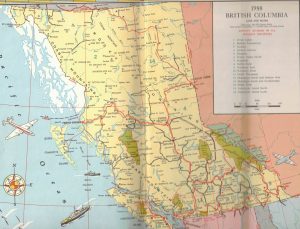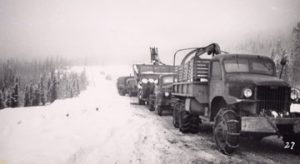Building the Alaska Highway in 1942-43 included more than heavy equipment and Canadian-American collaboration. Food shortages and coping with family life were factors too. The following excerpt from a family history, written by Anne Seierstad, shows her memories for the eight months of construction. While her new husband worked on the highway, she writes about being far from home, with food restrictions and rationing and a precarious supply chain.
In February 1943 we[i] moved to Dawson Creek to truck for Barney Norden on the Alaska Highway, and that was the furthest I had ever been away from home and family and it seemed we were off to the moon and would never get back to familiar places again.
We lived in a huge ten-roomed house [with] three other couples and one of the couples had two children. One other couple and child lived in their trailer in the yard, so after we got settled we could not be lonesome with so many friends around, because they had all come from Tilley, Alberta. We each had two or three rooms and each family lived separately. We five women kept ourselves busy while the men were away trucking on the Alaska Highway[ii].
They would be gone for a week or longer at a time especially if they had to go to Whitehorse or some other far off point. One of the ladies, Sadie, had a car so she would take us to town if we had to go. She also had a gas washing machine and iron, so we each teamed up with her and took in washing.
Before long we had all the customers we could handle, and could have had more as there were so many people living at Dawson Creek. The Americans set up army and civilian camps in the north, some worked on the Alaska Highway, the army was setting up for defense in the event Canada was attacked from the north. Included in the camps was one whole camp of Negroes[iii].
When we went shopping we could expect to wait in line for an hour or more at the store or Post Office and even the beer outlet. Dawson Creek was a town with a population of a thousand and with the camps of American army and civilians, and other people looking for work in this boom town, the population grew to many thousands.
Rationing for the war effort was in effect at the time, but at Dawson Creek, there were a lot of ordinary foods which were not available. Potatoes were one thing we did not eat all the time we were there, but macaroni was in good supply, so macaroni and cheese was our daily fare[iv].
Shipments of food and other things were snapped up as soon as they were brought in and if a person wasn’t on hand at the time, you naturally went without. One hard to get item was chewing gum and Sadie was an avid gum chewer, so every time we went to town, she would ask each of us to get her some gum so that she would never run out.
We always felt like not getting it for her, but we always got it though, and then we would grumble about the way she chewed it.
In the spring I planted a garden, Father had sent me some potato seeds, but we left there before the garden grew.
Endnotes
[i] In 1943 Anne was newly married and living in Tilley, Alberta when her husband got a truck- driving job on the Alaska Highway. Tilley is a hamlet in southeastern Alberta, between Medicine Hat and Brooks. Many thanks to Sandra Konrad, Anne’s daughter, who contributed her mother’s article.
[ii] The Alaska Highway from Dawson Creek, BC (Mile Zero) to Delta Junction, Alaska (Mile 1422) was built through wilderness, across muskeg swamps and over five mountain ranges in eight months in 1942-1943. More than 10,000 US Army Corps of Engineers were stationed in Alaska, BC and the Yukon with all of the equipment arriving in Dawson Creek by train. The building of the highway was a direct response to the bombing of Pearl Harbour, December 7, 1941, and the U.S. entry into World War II. At least 16,000 Canadian and American civilians were involved in the construction.
https://www.thecanadianencyclopedia.ca/en/article/alaska-highway
[iii] One third of the US Army Corps of Engineers were Black, from three African American regiments. According to several sources, they were subject to discrimination and unequal treatment in living conditions and supplies. They are credited with beginning the desegregation of the American armed forces.
https://themilepost.com/slideshows/building-the-alaska-highway/
[iv] We don’t have Anne’s recipe for macaroni and cheese recipe. WI District #14 – Peace River included this macaroni casserole recipe in “Supper Dishes”, the chapter they contributed to the 1958 BC Women’s Institute Centennial Cookbook (p. 230).




